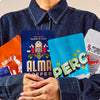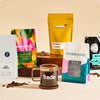Founded in 2013 by six St. Louis-based coffee experts, Blueprint Coffee is built on a rock-solid base.
Why did you choose the name Blueprint?
"A blueprint is an intelligent plan that represents a sound, real structure. We wanted to create our own blueprint for coffee, both in how we interact with our coffee bar customers and also our partners in coffee — producers, exporters, importers, wholesale clients, and vendors. We strive to create mutually beneficial partnerships that will make our business sound."
How did Blueprint get started roasting?
"Our green buyer, Andrew Timko, had years of experience roasting before becoming a founding partner of Blueprint Coffee. He took co-partner Mazi Razani under his wing when we opened, and together they have mastered our 23-kilo Gothot roaster. It’s a unique and old machine that was refurbished by Roasters Exchange. The way it moves air and some of the mods added by Roasters Exchange and Andrew give us some unique advantages when roasting, such as drum speed control and incoming heat tracking."
Tell us about the St. Louis roasting scene.
"St. Louis has exploded with independent roasters over the past five to eight years. It’s been paramount to the improvement of coffee’s reputation within the city. Ten years ago, roasters weren’t using the same language or markers to define specialty coffee. Now, with a symphony of voices marketing high-quality, seasonal, and traceable coffees, the consumers in St. Louis have a much clearer vision of what makes coffee great and where to get it. We’ve also seen a rise in the number of barista-led or barista-owned coffee bars in the city, which keeps success rooted in coffee quality."
How does your seasonal blend change throughout the year?
"Penrose blend changes with two main goals in mind. First, we want to keep the coffee seasonal so that it’s always tasting as fresh and vibrant as possible. Second, as components go out of season and stock, we need to find replacements that can create a delicious and consistent espresso — both on its own and as a base for milk drinks. We try to use coffees from our origin partners as often as possible for Penrose as it increases the positive impact we can have with them."
How did you design your logo?
"Kevin Reddy and Nora Brady, two of our founding partners, were inspired by Bauhaus architecture and cubism. A cube drawn in two dimensions is truly one of the simplest blueprints. In addition, the internal tetrahedron adds complexity and unique character. I like to say that the internal tetrahedron represents the many different forms our business takes. We are most obviously a coffee bar, but internally we are actually many businesses — coffee roasters, coffee consultants, coffee trainers, coffee equipment repair, and coffee equipment sales."
What inspired your public cupping program?
"I’ve got to give a big shout out here to my former employer Kaldi’s Coffee who started weekly cuppings at its roastery as early as 2007. It was at my first of these cuppings that I fell in love with specialty coffee. Also, it’s where I met my mentors, partners, and peers. Dedicated cuppers seem to have an enthusiasm and passionate pursuit of coffee. It’s a great setting to give people time to encounter and learn about coffee. We saw that weekly event blossom over the five years I was at Kaldi’s and I carried it into my following jobs. I’ve led hundreds (maybe thousands?) of public cuppings in the past 12 years, and the number of folks who have discovered specialty coffee through this method is astonishing. It doesn’t get old to me. I’m still leading one to two public cuppings a week in addition to the obligatory weekly coffee selection cuppings and occasional quality-assurance cuppings I attend."
What do you look for when sourcing coffees?
"Taste quality. Potential for partnership. Seasonality. Transparency. Curiosity. Progress. Sustainability. Equity."
What excites you most about specialty coffee?
"The industry is so young! While there’s plenty of deserved coffee-shop memes and latte art photos to last a thousand years, we are still just discovering what we can do to make coffee better — both in the cup and for those individuals involved in its production and sale. The best coffees in the world are only scoring 89 to 91 points when scored by a panel of Q Graders, so I think we still have room to grow. We observe this with optimism."
Where do you see Blueprint in five years?
"In five years, we still see ourselves rooted in St. Louis with a national reach through our website and wholesale partnerships. We are opening a third location this year, and once that is finished we will have a sizable retail presence in St. Louis. We still have a lot of internal opportunities for growth when it comes to roasting operations and space, wholesale partnerships, website retail, new products, and company culture. So, those will become more primary targets after we open number three."
Describe Blueprint in one word.
"Mutual"
— Mike Marquard, Co-Founder of Blueprint Coffee





